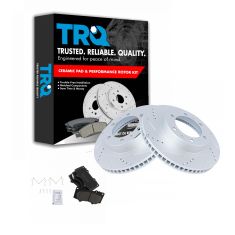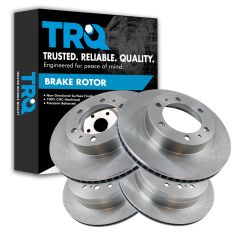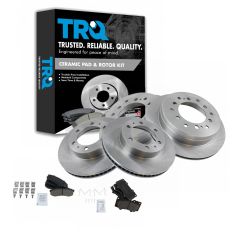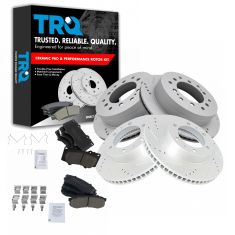1ABFS00354-Toyota 4Runner FJ Cruiser Tacoma Front Ceramic Brake Pad & Rotor Kit TRQ BKA10599
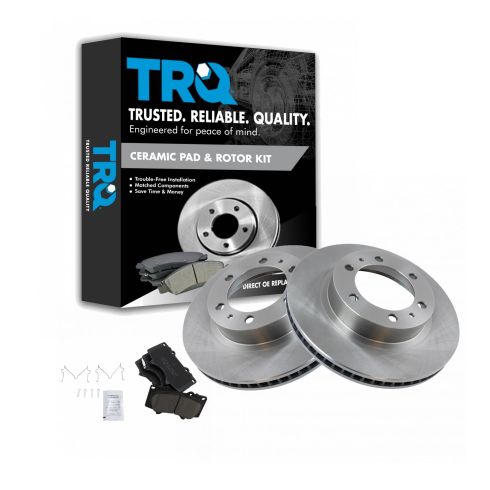
Replaces
2008 Toyota FJ Cruiser Front Ceramic Brake Pad & Rotor Kit TRQ BKA10599

Product Reviews
Loading reviews
4.70/ 5.0
43
43 reviews
Brake &Rotor set for 2014 Toyota Tacoma
February 1, 2017
The rotors were just as advertised on website! Brake pads fit perfectly! Awesome product! Would recommend to anyone!
Quality
September 25, 2018
This brake and rotor kit seems to be of excellent quality. At a reasonable price with fast free shipping.
January 30, 2019
Great product fit perfect. Easy install. Cheaper than the local auto stores. Highly recommend
2010 Tacoma brake pad/rotor set
November 22, 2019
Great price, quick shipping, good quality, what more can you ask for??
Nice and quick
January 6, 2020
Got everything I needed to get the job done and quickly!
Tacoma breaks
January 22, 2020
They showed up and they had everything for the job. Great price too.
Excellent
April 1, 2020
Brakes feel better than ever. Perfect fit. Excellent service. Very satisfied
Brake it, easy install
April 16, 2020
Thanks to the provide instructional video, this install was doable for someone with no previous brake work experience. Happy with the product, shipping, and service!
August 15, 2020
Rotors and pads fit fine. But the passenger side will not stop squeaking no matter what I do. Maybe I just got unlucky and received a bad set. I would not purchase again.
2007 FJ Cruiser
September 28, 2020
This was my first purchase from 1A Auto.
The parts arrived exactly when they said it would. I appreciate this, a lot
.
The rotors and pads fit perfectly, installation went well.
Please continue to make the excellent parts installation videos, I think they are great!
Works great, easy install
October 15, 2020
This was my very first DIY job on my 2003 4Runner, and I recommend this job for any virgin DIYer. It resolved some of the brake noise, but I think I need to replace my calipers to silence the brakes completely. The rotor replacement resolved the steering vibration when coming to a stop.
Brakes
November 26, 2020
The brake package that I ordered arrived on time. The fit great and work the way they should. Would highly recommend a1 auto to any one
Tacoma Rotor/brake kit
December 4, 2020
This kit fit my Tacoma 4wd perfect. The items were of good quality and the price was very reasonable. I would not hesitate to purchase from this company again. The shipping was quick as well.
June 29, 2021
Received product on time and overall quality of the product seems to be good.
August 10, 2021
They got warped very quickly and became really noisy
August 13, 2021
GREAT buy
Five stars from me
October 2, 2021
Fits as good as oem, at fraction of the price, well pleased
Perfect fit and function
[{"url": "https://wac.edgecastcdn.net/001A39/prod/media/pNISJll75W64CYGsite/8a05dbf2d67d06ae7bf416134d4de062_1636242995746_0.jpeg", "caption": ""}]
November 6, 2021
Installed on my 2007 Toyota Tacoma. Perfect fit and functions like new oem brakes. Highly recommended considering the great price.
[{"url": "https://wac.edgecastcdn.net/001A39/prod/media/pNISJll75W64CYGsite/1672cf6b04d4ffec89c832c066c6b73d_1636595495878_0.jpeg", "caption": "Very nice fit and quality. Brake job finished and smooth as silk at a very affordable price point."}]
November 10, 2021
Great product. Excellent price. Im impressed with the service, shipping, and packaging.
I will definitely use 1A again.
PERFECT
December 31, 2021
VERY IMPRESSED FITS AND WORKS GREAT DON'T DOUBT THE QUALITY THANKS 1A
Great replacement for OEM
January 2, 2022
My old brakes were warped and old. These brakes are great for the price and easy to install.
February 7, 2022
Everything matched up to original no problems came with everything I need thank you
Great value
March 22, 2022
Great product!
Excellent
May 14, 2022
Excellent brake pads and rotors!
June 4, 2022
They squeak and seem to rust prematurely
June 9, 2022
It's exactlywhat you said it would be. I put them on no problems. Got to me quickly too . Perfect, no complaints here. Fixin to order more parts . Thanks keep up the good work.
July 10, 2022
I finally got my truck brakes back.
Thank you guys dearly
July 17, 2022
Everything fit as it should, timely delivery.
Brake Job done well..
September 16, 2022
Great stuff. The rotor fit perfectly. The pads needed a little filing... but overall work great... I could not be happier with 1A Auto....
Awesome TRQ brakes pads for TOYOTA FJ.
October 1, 2022
It was a good product & perfect fit on my car. Highly recomended item. Thanks 1aauto.
Easy to decide what you need and fast delivery.
November 2, 2022
Good quality pads and rotors. Haven't needed to put them on as of yet. I would definitely recommend 1A Auto for all you automobile needs.
July 24, 2023
Very good rotors and brakes and wheel bearings. Thank you very much.
Awesome
July 27, 2023
Bought this for my 07FJ Cruiser and watched the 1a auto video on replacing my brakes and rotors. Easy job!! After 3k. No issues with brakes. Next project will be the rear brakes
Amazing!
August 13, 2023
Perfect fit, 1:1 replacement
good stuff
August 24, 2023
not sure about longevity, but these fit perfectly.
great parts
December 3, 2023
Great parts great fit have had good luck with TRQ parts .
January 15, 2024
Top quality products. Excellent price. Fit like advertised. Easy to install. Quick shipping, Will order from 1A Auto again.
Excellent
February 1, 2024
Good quality, fast shipping.
Fantastic
February 18, 2024
Fantastic service perfic fit stopping power great
Highly recommend
June 4, 2024
Parts fit perfectly as described. Zero issues. Price and shipping can't be beat. I highly recommend.
June 21, 2024
Good
Great product
July 12, 2024
My car stops and runs without any brake noises! Love your affordable products
July 27, 2024
Parts fit right and delivery was on time
Customer Q&A
if the item we order not needed at all do you give refund ?
August 1, 2022
10
Please refer to our returns FAQ for any info regarding our return process! https://www.1aauto.com/customer_service/support_faq#refunds
August 2, 2022
Tim K
Toyota is a registered trademark of Toyota Motor Corporation. 1A Auto is not affiliated with or sponsored by Toyota or Toyota Motor Corporation.
See all trademarks.








